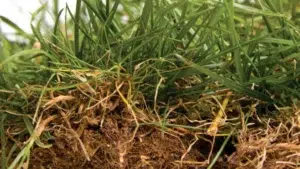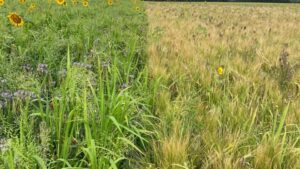The Radix Poa bulbosa cultivars are revolutionary, new and fully-protected products that create the opportunity to open significant new markets without competition. Poa bulbosa is the permanent, cool-season component of a turf combination with a warm-season grass, such as bermudagrass. According to Radix, this ‘cool-season permanency’ relieves the end-user of the necessity of over-seeding every fall.
Radix Research, Inc. has been exploring, developing and evolving the Poa bulbosa species for 15 years and has protected its material under a utility patent. Chad Miebach, a plant breeder, discovered techniques, allowing it to be hybridized. Radix believes it is the first entity to successfully hybridize and domesticate this species for turf applications.
Poa bulbosa germinates and grows in cool to cold conditions, and when it’s actively growing, it replenishes and increases the underground bulbs. In late March to early April, Poa bulbosa enters a comprehensive dormancy, completely disappearing from the soil surface, and cannot be forced to grow. This allows zero competition for the warm-season component of bermudagrass. Growth re-emerges from the underground bulbs in late September to mid October. Radix reports that Poa bulbosa germinates, grows more actively and retains color in much colder temperatures than other cool season grasses.
Poa bulbosa produces seed bulblets attached to the inflorescence above ground and also produces bulbs underground. The bulblets are asexual (clones of the mother) and therefore, reproduce true to type. The bulblets have a hard outer shell and high specific gravity making seed cleaning and processing efficient and effective.
Usage and sales trends have seen tall fescue expand and capture much of the Kentucky bluegrass markets. Likewise, bermudagrass can be expected to soon move into what were the more traditional tall fescue markets.
The combined turf setting of Poa bulbosa/bermuda is more drought tolerant and water-use efficient than tall fescue. Under dry conditions, tall fescue can survive for a period of time, but will suffer weakening and eventually death without supplemental irrigation. Poa bulbosa/bermuda is able to survive and re-establish healthy turf stands, intact, after extended dry periods. Radix explains that this gives the Poa bulbosa/bermuda much more elasticity in the presence of ever increasing water use restrictions. Poa bulbosa was observed to re-emerge intact after 1 year of non-irrigation near Tucson, Arizona.
Bermudagrass is more widely adapted and winter hardy than commonly acknowledged. Radix has used bermudagrass collections from intact turf stands found in central Washington, central Michigan, central Pennsylvania and central Kansas to name a few locations. The company has developed and licensed the bermudagrass varieties Blackjack and Maya, which are both successful, high quality and winter hardy warm-season complements for Poa bulbosa. Radix reports it will have a minimum of two new bermudagrass cultivars ready for seed stock multiplication in the summer of 2017.
Radix has also developed Poa bulbosa cultivars adapted to understory conditions of vineyards and orchards in many climates, as well as cultivars adapted to winter over-seeding dormant bermudagrass pastures.
Radix is increasing seed bulblets of top performing hybrid cultivars. The company expects first commercial production and availability is expected from crop 2018.













